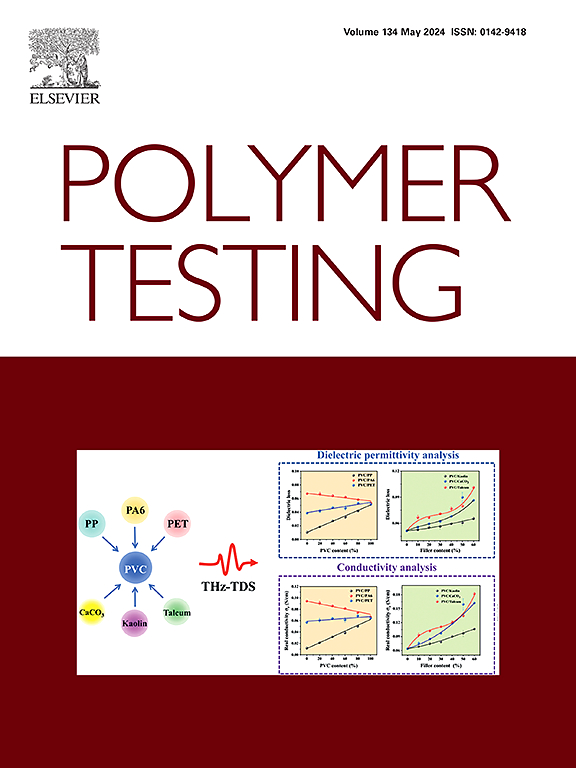工艺参数对碳纤维增强聚醚醚酮复合材料螺杆挤压3D打印性能的敏感性分析
IF 6
2区 材料科学
Q1 MATERIALS SCIENCE, CHARACTERIZATION & TESTING
引用次数: 0
摘要
基于螺杆挤压的材料挤压因其广泛的材料加工能力和高兼容性而受到越来越多的关注。然而,螺杆挤压工艺参数与零件性能之间的关系还有待进一步研究。本研究旨在研究短碳纤维增强聚醚酮(SCF/PEEK)打印件的力学性能对螺杆挤压3D打印工艺参数的敏感性。采用数值模拟与试验相结合的方法,研究了不同工艺参数对零件力学性能的影响。结果表明,在挤压过程中,挤压温度、速度和喷嘴直径对熔体挤压压力有显著影响。对零件强度影响最大的参数是打印温度和退火温度,其次是填充角度、喷嘴直径、打印层高度和打印线宽度,打印速度和退火时间对强度影响较小。在优化的工艺参数下,试样的最大抗拉强度和最大抗弯强度分别达到148.8 MPa和222.1 MPa。工艺参数通过影响层间或层内结合、孔隙率和结晶度来影响试样的力学性能和表面形貌。本研究为提高螺杆挤压3d打印部件的性能提供了重要的理论基础和实践指导,促进了该领域的进一步应用。本文章由计算机程序翻译,如有差异,请以英文原文为准。
Sensitivity analysis of process parameters on the properties of carbon fiber reinforced polyether-ether-ketone composites in screw extrusion 3D printing
Material extrusion based on screw extrusion has garnered increasing attention due to its extensive material processing capabilities and high compatibility. However, the relationship between the process parameters in screw extrusion and the properties of the parts requires further investigation. The study aims to investigate the sensitivity of the mechanical properties of short carbon fiber-reinforced polyether-ether-ketone (SCF/PEEK) printed parts to the process parameters in screw extrusion 3D printing. The effects of varying process parameters on the mechanical properties of the parts were investigated through a combination of numerical simulation and experimental testing. The results indicate that extrusion temperature, speed, and nozzle diameter significantly influence the melt extrusion pressure during the extrusion process. Regarding part strength, the most influential parameters were printing temperature and annealing temperature, followed by filling angle, nozzle diameter, printing layer height, and printing line width, while printing speed and annealing time had relatively minor effects on strength. Under the optimized process parameters, the maximum tensile and flexural strengths of the specimens reached 148.8 MPa and 222.1 MPa, respectively. The process parameters affect the mechanical properties and surface morphology of the specimen by influencing the inter- or intra-layer bonding, porosity, and crystallinity. This research offers a crucial theoretical foundation and practical guidance for enhancing the performance of screw-extruded 3D-printed parts, facilitating further applications in this field.
求助全文
通过发布文献求助,成功后即可免费获取论文全文。
去求助
来源期刊

Polymer Testing
工程技术-材料科学:表征与测试
CiteScore
10.70
自引率
5.90%
发文量
328
审稿时长
44 days
期刊介绍:
Polymer Testing focuses on the testing, analysis and characterization of polymer materials, including both synthetic and natural or biobased polymers. Novel testing methods and the testing of novel polymeric materials in bulk, solution and dispersion is covered. In addition, we welcome the submission of the testing of polymeric materials for a wide range of applications and industrial products as well as nanoscale characterization.
The scope includes but is not limited to the following main topics:
Novel testing methods and Chemical analysis
• mechanical, thermal, electrical, chemical, imaging, spectroscopy, scattering and rheology
Physical properties and behaviour of novel polymer systems
• nanoscale properties, morphology, transport properties
Degradation and recycling of polymeric materials when combined with novel testing or characterization methods
• degradation, biodegradation, ageing and fire retardancy
Modelling and Simulation work will be only considered when it is linked to new or previously published experimental results.
 求助内容:
求助内容: 应助结果提醒方式:
应助结果提醒方式:


